Helichrysum pedunculatum
Helichrysum pedunculatum Hilliard & B.L.Burtt
Family: Asteraceae
Common names: pedunculate helichrysum (Eng.), isicwe (isiXhosa & isiZulu)
Introduction
Helichrysum pedunculatum is a perennial herb that is distinguished by its large flower heads and aromatic, bicoloured leaves that are glossy above and felted below.
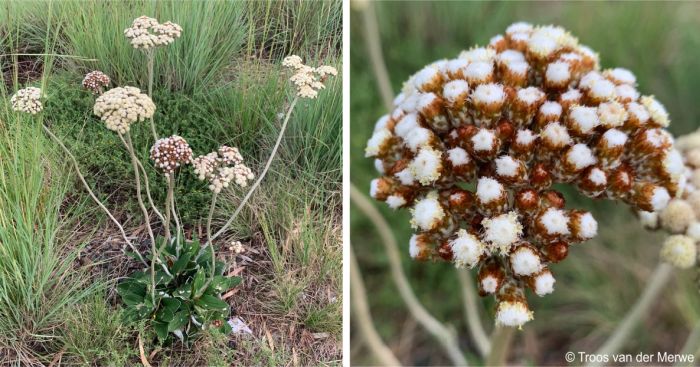
Description
Description
Helichrysum pedunculatum is an evergreen, fast-growing perennial herb that can grow up to 500 mm tall. The stem is erect, single, unbranched, white-woolly, from a woody rootstock. The leaves are broadly elliptic, the upper surface is smooth and hairless, while the lower surface has a skin of silky-woolly felted hairs. Most of the leaves arise from the root (radical), are up to 130 x 40 mm, and taper to a petiole-like base. The stem leaves are sessile.
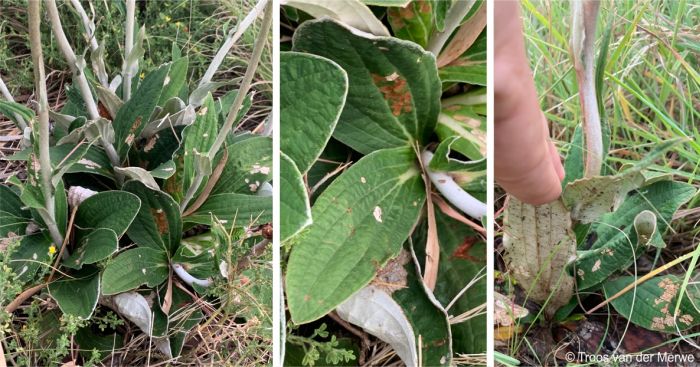
The flowers of Helichrysum pedunculatum are white to cream, in bell-shaped, discoid heads, 7.5 x 7 mm, with reddish-brown involucral bracts. Many flower heads are arranged in a crowded, branched inflorescence at the tip of the stem that starts out very compact and rounded becoming loose and flattish as the flowers open. The flowering time is in summer (November to February). The seeds are small and brown.
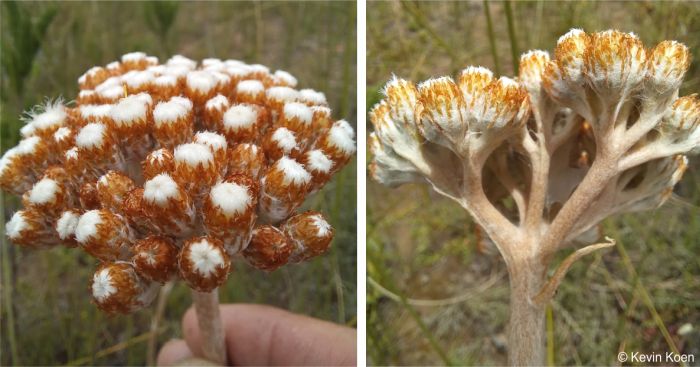
Conservation Status
Status
According to the Red list of South African Plants, Helichrysum pedunculatum is not threatened and is listed as a species of Least Concern (LC).
Distribution and habitat
Distribution description
Helichrysum pedunculatum is endemic to southern Africa, it occurs in South Africa, and in the southern part of Lesotho. In South Africa, its provincial distribution is Eastern Cape, Free State and Western Cape. It grows in the Grassland, Savanna, Thicket and Nama Karoo Biomes at 30 –1 525 m above sea level.
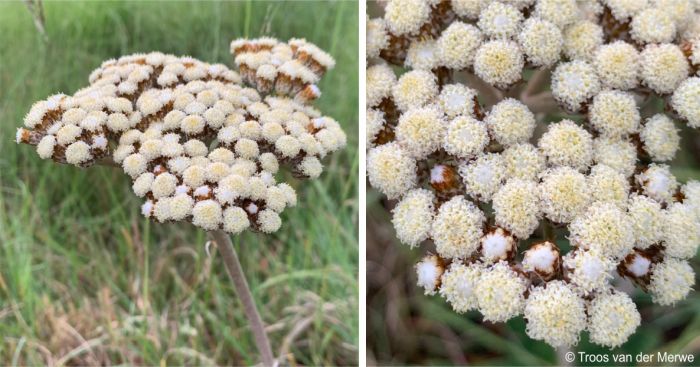
Derivation of name and historical aspects
History
The genus name Helichrysum, is derived from the Greek word helios meaning ‘sun’ and chrysos meaning ‘gold’, referring to the usually bright yellow flowers of plants in the genus. The specific epithet pedunculatum means ‘with a peduncle’ or ‘possessing a peduncle’, which refers to the long peduncle-like stem.
The genus Helichrysum belongs to one of the largest and best known families, Asteraceae, the daisy family, that contains about 1 530 genera worldwide and 22 800 species. About 240 species of Helichrysum are indigenous to South Africa. Closely related species to Helichrysum pedunculatum are H. nudifolium and H. longifolium, which can be distinguished by their leaves and the colour of their flowers. Many species of Helichrysum are used as traditional medicine and cultivated in gardens in South Africa and are known for their colourful flowers, often attractive foliage and interesting variety of forms.
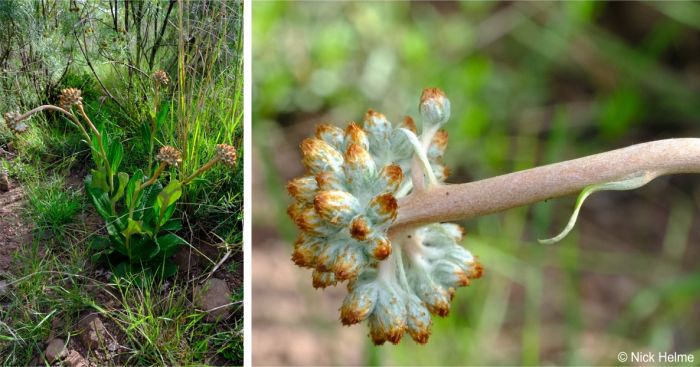
Ecology
Ecology
The silky-woolly-felted skin helps prevent water loss, which makes this plant water-wise. The flower heads of Helichrysum pedunculatum attract a variety of pollinating insects, including bees. The seeds are small, lightweight, and are easily dispersed by wind.
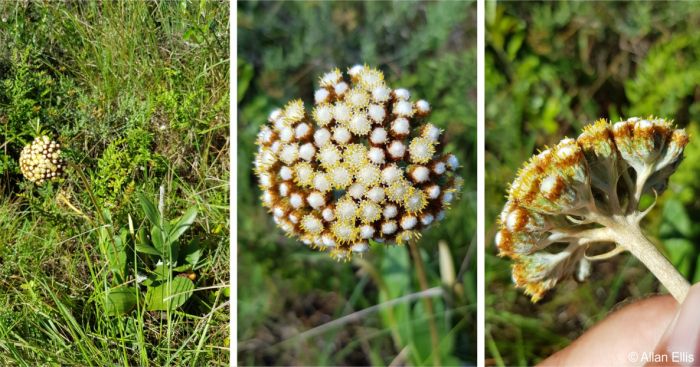
Uses
Use
Many species of Helichrysum are used medicinally for various purposes. H. pedunculatum is used traditionally by Xhosa people to dress the wound acquired during male circumcision, the leaf serves as an antibacterial dressing. It can also be used to dress infected sores, and the roots can be used to treat coughs and colds. It can be planted as water-wise garden plant, and can be used in low-maintenance gardens. H. pedunculatum is also used as a natural dye for fabrics and as a food flavouring.
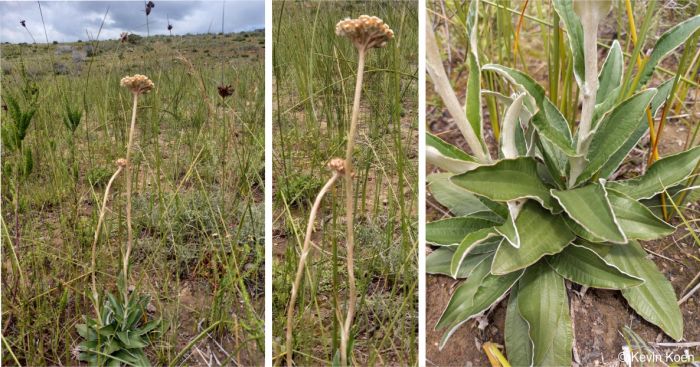
Growing Helichrysum pedunculatum
Grow
Helichrysum pedunculatum best grown in full sun to partial shade. It is drought tolerant and can tolerate a wide range of soil types. The species grow best in well-drained soils. Propagation of Helichrysum pedunculatum can be done by seed or division. Sow seeds in autumn (March-May) or in spring (Sept-Oct), seeds must be covered lightly in well-drained, compost, sandy or loamy soil and the open seed tray must be kept moist.Large clumps can be lifted and divided during the winter season (June–August).
References
- Arnold, T.H. & de Wet, B.C. 1993. Plants of southern Africa: names and distribution. Memoirs of the Botanical Survey of South Africa No. 62.
- Bredenkamp, C.L. 2019. A flora of the Eastern Cape Province, Volume 1. Strelitzia 41. SANBI, Pretoria.
- Ellis, A. 2022-Jan. Observation of Helichrysum pedunculatum, Haga Haga, EC. iNaturalist. Online. https://www.inaturalist.org/observations/145928694.
- Goldblatt, P. & Manning, J. 2000. Cape Plants. A conspectus of the Cape flora of South Africa. Strelitzia 9. National Botanical Institute, Pretoria & Missouri Botanical Garden, Missouri.
- Helme, N. 2022-Jan. Observation of Helichrysum pedunculatum, Queenstown, EC. iNaturalist. Online. https://www.inaturalist.org/observations/105308640.
- Koen, K. 2020-Nov. Observation of Helichrysum pedunculatum, Herbertsdale, EC. iNaturalist. Online. https://www.inaturalist.org/observations/66033659.
- Pooley, E. 2003. Mountain flowers, a field guide to the flora of the Drakensberg and Lesotho. Natal Flora Publications Trust, Durban.
- Raimondo, D., Von Staden, L., Foden, W., Victor, J.E., Helme, N.A., Turner, R.C., Kamundi, D.A. & Manyama, P.A. (eds) 2009. Red list of South African plants. Strelitzia 25. South African National Biodiversity Institute, Pretoria.
- Van der Merwe, T. 2020-Dec. Observation of Helichrysum pedunculatum, Lady Grey, EC. iNaturalist. Online. https://www.inaturalist.org/observations/67392904.
- Van Wyk, B.-E. & Gericke, N. 2000. People's plants. Briza Publications, Pretoria.
Credits
Mashudu Tshitereke
KwaZulu-Natal National Botanical Garden
January 2025
Acknowledgements: images by Allan Ellis, Kevin Koen, Nick Helme and Troos van der Merwe from their observations on iNaturalist.
Plant Attributes:
Plant Type: Perennial
SA Distribution: Eastern Cape, Free State
Soil type: Loam
Flowering season: Early Summer, Late Summer
PH:
Flower colour: Brown, White, Cream
Aspect: Full Sun, Morning Sun (Semi Shade), Afternoon Sun (Semi Shade)
Gardening skill: Easy
Special Features:
Horticultural zones
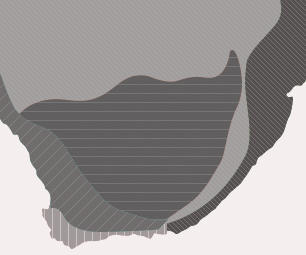









Rate this article
Article well written and informative
Rate this plant
Is this an interesting plant?
Login to add your Comment
Back to topNot registered yet? Click here to register.